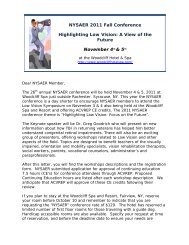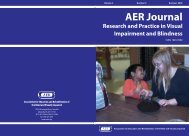Association for Education and Rehabilitation of the Blind - AER Online
Association for Education and Rehabilitation of the Blind - AER Online
Association for Education and Rehabilitation of the Blind - AER Online
Create successful ePaper yourself
Turn your PDF publications into a flip-book with our unique Google optimized e-Paper software.
International Research Report<br />
A Comparative Study <strong>of</strong> Integrated<br />
<strong>Education</strong>al Facilities in Nepal<br />
Kamal Lamichhane, PhD*<br />
The University <strong>of</strong> Tokyo<br />
Meguro, Tokyo, Japan<br />
Keywords: integrated education, visual impairment, Nepal, teachers <strong>of</strong> students with visual impairments<br />
(TVIs)<br />
Introduction<br />
According to <strong>the</strong> Central Bureau <strong>of</strong> Statistics,<br />
Nepal, <strong>the</strong> total population <strong>of</strong> Nepal at <strong>the</strong> time <strong>of</strong> <strong>the</strong><br />
most recent census (2001) was 23,151,423. Of this<br />
population, <strong>the</strong> report <strong>of</strong> <strong>the</strong> 1981 Nepal <strong>Blind</strong>ness<br />
Survey estimated that 117,623 people were blind<br />
(0.84 percent at <strong>the</strong> time), 259,888 people (1.85<br />
percent) had low vision, <strong>and</strong> 233,612 people (1.66<br />
percent) were blind in one eye (His Majesty’s<br />
Government <strong>of</strong> Nepal, 2002). As <strong>for</strong> a precise<br />
statistic, nei<strong>the</strong>r <strong>the</strong> exact number nor any numbers<br />
more recent than this can be ascertained because <strong>of</strong><br />
<strong>the</strong> unavailability <strong>of</strong> updated data. These statistics<br />
were derived from a population <strong>of</strong> 39,887 individuals<br />
(Brilliant, Pokhrel, Grasset, & Brilliant, 1988). This<br />
report fur<strong>the</strong>r mentioned that 80 percent <strong>of</strong> <strong>the</strong><br />
blindness was found to be avoidable <strong>and</strong> curable.<br />
Cataracts <strong>and</strong> glaucoma were <strong>the</strong> primary causes <strong>of</strong><br />
avoidable blindness, with cataracts accounting <strong>for</strong> 70<br />
percent <strong>of</strong> cases (Brilliant et al., 1988).<br />
In 1964, <strong>the</strong> Laboratory School <strong>of</strong> Kathm<strong>and</strong>u<br />
opened its doors <strong>for</strong> <strong>the</strong> first time to students with<br />
visual impairments (Prasad, 2003; UNICEF Regional<br />
Office <strong>for</strong> South Asia 2003). The school’s program<br />
was referred to as ‘‘integrated education,’’ meaning<br />
that students with visual impairments studied<br />
toge<strong>the</strong>r with students without disabilities in <strong>the</strong><br />
same classroom (Hall, 1990). The program’s main<br />
innovation was <strong>the</strong> introduction <strong>of</strong> skill-based classes<br />
* Please address correspondence to<br />
kamal@bfp.rcast.u-tokyo.ac.jp;<br />
kamalnsdn@gmail.com.<br />
34 | Received September 13, 2009; Accepted February 16, 2010<br />
<strong>for</strong> students with visual impairments prior to <strong>the</strong>ir<br />
placement in mainstream classes.<br />
Integrated education refers to <strong>the</strong> meaningful<br />
involvement <strong>of</strong> children with disabilities in ongoing<br />
regular educational programs. The ultimate goal <strong>of</strong><br />
integrated education is <strong>the</strong> optimal academic <strong>and</strong> social<br />
as well as personal learning <strong>of</strong> each child (Namgayel,<br />
1985). The development <strong>of</strong> integrated education as an<br />
educational approach represents an attempt to address<br />
<strong>the</strong> flaws <strong>of</strong> segregated schooling: Integrated education<br />
helps to bridge <strong>the</strong> gap between those with <strong>and</strong> without<br />
disabilities, raising awareness about disability issues by<br />
starting with society’s youngest members.<br />
Today in Nepal, integrated education has been<br />
accepted as a component <strong>of</strong> <strong>the</strong> community-based<br />
rehabilitation (CBR) <strong>of</strong> persons with visual impairments.<br />
The Nepal <strong>Association</strong> <strong>for</strong> <strong>the</strong> Welfare <strong>of</strong> <strong>the</strong><br />
<strong>Blind</strong> (NAWB), established in 1986, continues to play a<br />
major role in <strong>the</strong> expansion <strong>of</strong> integrated education<br />
along with CBR programs in different parts <strong>of</strong> <strong>the</strong><br />
country (Hall, 1990). At <strong>the</strong> time <strong>of</strong> this research, <strong>the</strong>re<br />
are 73 NAWB-supported schools providing integrated<br />
education <strong>for</strong> students with visual impairments, each<br />
with arrangements <strong>for</strong> at least one teacher <strong>of</strong> students<br />
with visual impairments (TVIs). TVIs teach skill-based<br />
resource classes, which students with visual impairments<br />
attend prior to joining integrated classes.<br />
Typically, <strong>the</strong>se resource classes are established<br />
within local schools that have facilities such as<br />
separate classrooms to accommodate resource<br />
classes (UNICEF Regional Office <strong>for</strong> South Asia,<br />
2003). Students with visual impairments remain in<br />
<strong>the</strong>se resource classes until <strong>the</strong>y gain such necessary<br />
skills as <strong>the</strong> use <strong>of</strong> braille, independent living skills<br />
(ILSs), <strong>and</strong> orientation <strong>and</strong> mobility (O&M), after which







